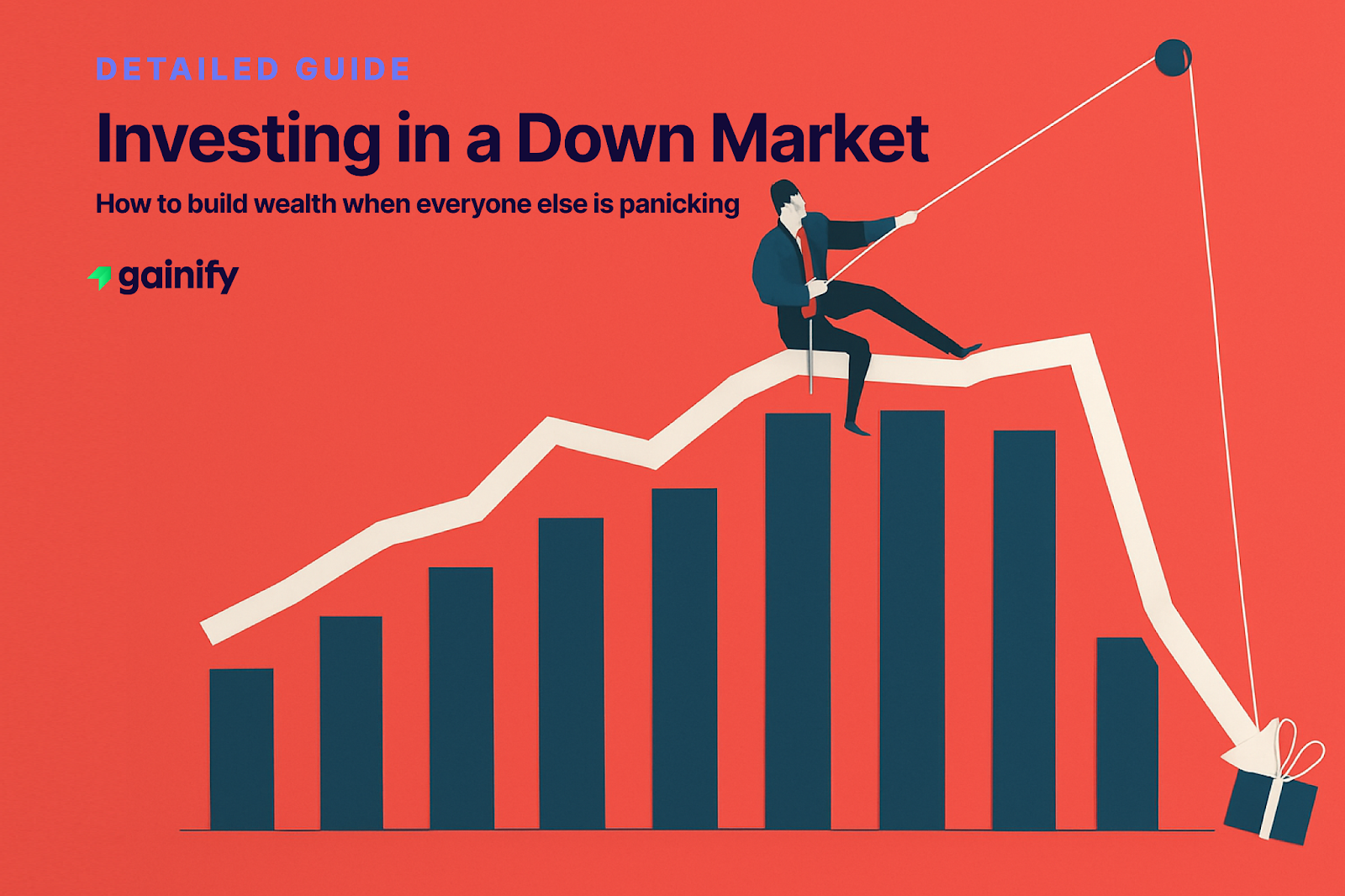Picture this: The headlines are bleak. Stock market losses dominate the news. Analysts are cutting forecasts. CNBC is running special coverage with ominous music. Your investment account is down, your confidence is shaken, and your instincts are screaming:
Do something!
But what if doing less, or even the opposite of the crowd, is how you come out ahead?
Investing in a down market is not about guessing the bottom or making bold, risky bets. It is about understanding how market cycles work, recognizing human behavior in crisis, and using time-tested investment strategies that work when emotions run high.
Here is the truth: Every bear market has eventually been followed by a bull market.
That does not mean every company bounces back, but the broader market such as the S&P 500 Index has shown repeatedly that downturns create entry points. What separates the winners from the losers is not who avoids the storm, but who navigates it with a clear investment plan, diversified portfolio, and long-term investment mindset.
Volatility is uncomfortable, but it is not new. The US stock market has endured wars, inflation spikes, recessions, and bubbles. Long-term growth has rewarded those who remained disciplined.
So what is the key?
It’s having a strategy that balances smart stock selection with risk control. Identifying individual companies with strong fundamentals, durable earnings, and competitive advantages can be just as critical as broader asset allocation. In volatile markets, focus shifts from hype to quality. Market downdrafts reward those who consistently invest in well-researched stocks, especially those trading below intrinsic value. Knowing when to lean into single names versus leaning on ETFs, index funds, or money market funds is part of a disciplined investment plan.
Let us break it down step by step.
What Is a Down Market?
A down market typically refers to a prolonged period of falling asset prices, especially in equities. If the market drops 20% or more from a recent peak, it is often considered a bear market. The Nasdaq Composite and S&P 500 Index are common reference points for identifying such trends.
Key Characteristics:
- Declining stock prices across major indices
- Increased stock market volatility
- Worsening investor sentiment
- A shift toward conservative investments like bonds or money market funds
These conditions often occur during periods of rising interest rates, macro headwinds, declining earnings, or heightened geopolitical uncertainty.
Why Most Investors Panic and Why You Should Not
Retail investors frequently make poor investment decisions during turbulent periods. They get caught up in market noise and let emotions override logic. Behavioral finance studies show a pattern: buying high and selling low.
In a down market, experienced investors focus on core fundamentals rather than short-term noise. They look at company valuations, earnings potential, and economic indicators. Many investment professionals, including those at major bank advisory teams, emphasize that market volatility is temporary while investment goals are long term. Instead of reacting emotionally, they encourage clients to stay disciplined and maintain perspective.
History supports this view. After the 2008 financial crisis, the S&P 500 Index more than tripled over the following decade. Those who sold during the downturn locked in losses. Those who stuck to a consistent strategy often saw substantial gains.
How to Invest in a Down Market
1. Refocus on Asset Allocation
A market downturn is an ideal time to revisit your portfolio’s structure. Assess whether your current mix of equities, fixed income, cash, and alternative investments still aligns with your long-term goals and risk tolerance. Rebalancing may involve reducing exposure to overheated sectors or increasing allocations to undervalued asset classes. The goal is to maintain a disciplined strategy rather than letting recent market movements dictate allocation.
2. Practice Dollar-Cost Averaging (DCA)
Rather than making large, one-time investments, continue contributing regularly to your investment accounts. Dollar-cost averaging allows you to purchase more shares when prices are low and fewer when prices are high, which can lower your average cost per share over time. This approach helps reduce the emotional pressure of trying to choose the “right” moment to invest and keeps your long-term plan on track regardless of short-term volatility.
3. Strengthen Diversification
A well-diversified portfolio is one of the most effective ways to manage risk during a downturn. Consider broadening your exposure across sectors, geographies, and asset types. Low-cost index funds and ETFs offer efficient diversification, while dividend-paying stocks can provide income and stability. Diversification does not eliminate risk, but it helps reduce the impact of sharp declines in any single area of the market.
4. Explore Tax-Loss Harvesting
In taxable investment accounts, market pullbacks can create opportunities to improve after-tax returns. By selling securities that have declined in value, you can realize capital losses that may be used to offset capital gains elsewhere in your portfolio. These losses can also be carried forward to reduce taxable gains in future years. Be mindful of the wash-sale rule, and consider reinvesting proceeds into similar, but not identical investments to maintain your market exposure.
5. Avoid Chasing Market Bottoms
Attempting to predict the exact market bottom is nearly impossible, even for professionals. Many investors miss the early stages of a recovery by waiting on the sidelines. Rather than guessing when the market has fully bottomed, stay invested in accordance with your long-term strategy. Focus on high-quality assets with strong fundamentals and continue adding to positions in a disciplined, incremental way.
When Growth Matters: Focus on Future Earnings
Market downturns often create the conditions for the next generation of market leaders. History shows that many of today’s most dominant companies, particularly in the technology and healthcare sectors, were either founded or significantly expanded during periods of economic stress. These firms gained lasting competitive advantages by investing in innovation, expanding operations, or acquiring market share while their peers were scaling back. For long-term investors, identifying companies that not only survive but thrive during downturns can be a source of exceptional returns.
To make these opportunities actionable, it is important to understand how market capitalization-weighted indexes behave. In these indexes, the performance of large, influential companies drives overall market returns. As economic sentiment begins to shift, investors typically rotate toward firms with strong growth potential and durable business models. These leaders often pull the broader index higher, even while weaker companies continue to struggle. Recognizing which companies are positioned to lead the next cycle helps investors focus on the true drivers of recovery.
This is where forward-looking analysis becomes critical. During a recession, earnings may appear depressed, but equity markets generally begin to recover before improvements show up in company reports or economic data. Investors who focus only on trailing results often miss the inflection point. Instead, evaluating future earnings potential, industry momentum, and structural tailwinds provides a more accurate picture of long-term value. Markets reward growth that is not yet fully priced in, especially when supported by sound fundamentals.
Strong balance sheets and reliable cash flows provide another layer of resilience. Companies with minimal debt, high liquidity, and operational discipline can continue funding key initiatives and withstand pressure without diluting shareholder value. These businesses are often able to reinvest when competitors cannot, which improves their positioning once the recovery begins. Over time, this financial strength compounds into better performance and higher investor confidence.
Sector dynamics further sharpen the focus. Certain industries tend to lead during different phases of the economic cycle. After a recession, sectors such as technology, industrials, and consumer discretionary often rebound early due to their sensitivity to improving economic conditions. These sectors also tend to benefit from capital investment, policy support, and pent-up demand. Tracking earnings revisions, capital allocation trends, and shifts in institutional flows within these areas can help investors identify promising opportunities ahead of the broader recovery.
The Contrarian View: Sometimes Cash Is a Strategy
While long-term investing is a proven path to wealth, there are times when holding cash is a smart and deliberate choice. In volatile or uncertain markets, capital preservation and financial flexibility can outweigh the pursuit of immediate returns. Cash, when used strategically, is not a sign of indecision. It is a tool for risk management and future opportunity.
Cash and cash equivalents provide stability when other asset classes become unpredictable. Instruments such as money market funds, Treasury bills, and short-duration bonds typically offer low volatility, high liquidity, and reliable income. These features make them especially valuable during periods of sharp market drawdowns or tightening credit conditions.
Liquidity becomes even more important when your financial foundation is not yet secure. If the market is deteriorating and your emergency savings are insufficient, continuing to invest aggressively could expose you to unnecessary downside risk. Building or maintaining an adequate cash reserve ensures that you do not need to sell long-term investments at unfavorable prices to cover near-term needs.
Managing risk tolerance is essential during turbulent markets. Many investors misjudge their ability to withstand volatility until they experience significant losses. In such cases, reallocating to cash can help reduce emotional decision-making and allow time for reassessment. It is not about trying to predict short-term movements, but about staying grounded in a strategy that reflects your actual risk capacity.
Opportunity cost is real, but so is the cost of capital loss. While cash may underperform equities in strong markets, it protects purchasing power and safeguards against forced liquidation during downturns. The aim is not to sit out the recovery, but to preserve the ability to participate in it from a position of strength.
In portfolio construction, cash should be viewed as a strategic allocation, not a placeholder. It offers optionality, cushions volatility, and creates dry powder to deploy when valuations improve or new opportunities arise. For patient, disciplined investors, the flexibility to act decisively when others are constrained can be a powerful advantage.
Final Thoughts: Mastering the Market’s Ups and Downs
Market volatility is a natural part of investing. The most successful investors are not those who avoid every downturn, but those who stay committed to a process and remain grounded when uncertainty takes over. Long-term results come from consistency, not perfection.
During turbulent periods, the key is to refocus on what truly matters. Fundamentals such as earnings strength, cash flow, and valuation should guide decisions, not headlines or short-term sentiment. These are the tools that help investors make rational choices when others are reacting emotionally.
Downturns can be uncomfortable, but they often present the most valuable opportunities. Lower prices create openings to invest in high-quality assets, rebalance portfolios, or enter sectors poised for recovery. Acting strategically in difficult environments can set the stage for long-term growth.
Building wealth through investing is rarely smooth. It requires patience, perspective, and the discipline to stick to your plan when markets are moving against you. Those who stay invested with intention and adapt thoughtfully tend to come out stronger on the other side.
Mastering the market is not about knowing what will happen next. It is about being prepared, staying focused on long-term goals, and making decisions that reflect both confidence and resilience.
FAQ: Investing in a Down Market
Q: Is it a good idea to invest in the stock market during downturns?
A: Historically, yes. Downturns often present opportunities to buy high-quality assets at lower prices. The key is to maintain a diversified portfolio and stick to your investment strategy.
Q: How does stock market volatility affect long-term investment goals?
A: Volatility can create anxiety, but over longer horizons, it usually smooths out. Keeping focus on your investment horizon helps avoid emotional missteps.
Q: Are bonds a better choice during a market crash?
A: Sometimes. Bonds can reduce portfolio volatility, but returns depend on the interest rate environment. In some market downturns, bonds have acted as a hedge, but not always.
Q: What is the role of index funds during market corrections?
A: Index funds provide broad exposure at low cost. They are particularly helpful during corrections because they remove stock-picking risk and track the market recovery.
Q: Should I work with an investment professional during volatile periods?
A: Yes, especially if you are unsure how to allocate or rebalance. An advisor can help you avoid mistakes and align your portfolio with market cycles.
Q: What does it mean to invest through market cycles?
A: It means staying invested through various stages such as expansion, peak, recession, and recovery while adjusting your approach based on current conditions.
Q: How can I use dividends during downturns?
A: Dividend-paying stocks offer a cash return even during price declines. Reinvesting those dividends can enhance compounding during recoveries.
Q: What is the value of having diverse investments during a downturn?
A: A mix of assets such as stocks, bonds, and commodities spreads risk. Diverse investments often outperform concentrated ones when volatility strikes.




